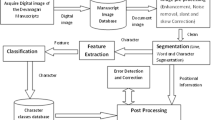Abstract
OCR systems capable of recognizing characters have gained maximum concentration of researchers these days, especially when it comes to recognizing ancient documents. Digitization of these documents to make them readable and also searching from paper-based data becomes a great challenge. Literature shows that there are a lot of OCR systems that use different feature extraction and segmentation techniques to calculate the recognition accuracy. This paper focuses on a variety of classifiers and feature extraction techniques used to segment characters individually to make them readable by machines. The purpose of recognition of these documents is to preserve the heritage and valuable information contained in ancient manuscripts written in different languages.
Access this chapter
Tax calculation will be finalised at checkout
Purchases are for personal use only
Similar content being viewed by others
References
Kumar M, Sharma RK, Jindal MK (2012) Offline handwritten Gurmukhi character recognition: Study of different feature-classifier combinations. In: Proceeding of the workshop on Document Analysis and Recognition, pp 94–99
Bansal V, Sinha MK (2001) A complete OCR for printed Hindi text in Devanagari script. In: Proceedings of 6th international conference on document analysis and recognition. IEEE Computer Society, p 0800
Arora S, Bhatcharjee D, Nasipuri M, Malik L (2007) A two stage classification approach for handwritten Devnagari characters. In: International conference on computational intelligence and multimedia applications (ICCIMA 2007). IEEE, vol 2, pp 399–403
Lehal GS (2009) Optical character recognition of Gurmukhi script using multiple classifiers. In: Proceedings of the international workshop on multilingual OCR, pp 1–9
Shao Y, Wang C, Xiao B (2015) A character image restoration method for unconstrained handwritten Chinese character recognition. Int J Document Anal Recog (IJDAR) 18(1):73–86
Dalal N, Triggs B (2005) Histograms of oriented gradients for human detection. In: 2005 IEEE computer society conference on computer vision and pattern recognition (CVPR’05). IEEE, vol 1, pp 886–893
Hussain J (2018) A hybrid approach handwritten character recognition for Mizo using artificial neural network. In: 2018 international conference on advanced computation and telecommunication (ICACAT). IEEE, pp 1–6
Singh J, Lehal GS (2014) Comparative performance analysis of feature (S)-classifier combination for Devanagari optical character recognition system. Int Jo Adv Comput Sci Appl (IJACSA) 15
Narang S, Jindal MK, Kumar M (2019) Devanagari ancient documents recognition using statistical feature extraction techniques. Sdhan 44(6):1–8
Narang SR, Jindal MK, Kumar M (2019) Devanagari ancient character recognition using DCT features with adaptive boosting and bootstrap aggregating. Soft Comput 23(24):13603–13614
Narang SR, Jindal MK, Kumar M (2019) Drop flow method: an iterative algorithm for complete segmentation of Devanagari ancient manuscripts. Multimedia Tools Appl 78(16):23255–23280
Mahto MK, Bhatia K, Sharma RK (2015) Combined horizontal and vertical projection feature extraction technique for Gurmukhi handwritten character recognition. In: 2015 international conference on advances in computer engineering and applications. IEEE, pp 59–65
Singh P, Budhiraja S (2011) Feature extraction and classification techniques in OCR systems for handwritten Gurmukhi Script-a survey. Int J Eng Res Appl (IJERA) 1(4):1736–1739
Narang SR, Jindal MK, Sharma P (2018) Devanagari ancient character recognition using HOG and DCT features. In: 2018 5th international conference on parallel, distributed and grid computing (PDGC). IEEE, pp 215–220
Khanduja D, Nain N, Panwar S (2015) A hybrid feature extraction algorithm for devanagari script. ACM Trans Asian Low-Resour Lang Inf Process (TALLIP) 15(1):1–10
Author information
Authors and Affiliations
Corresponding author
Editor information
Editors and Affiliations
Rights and permissions
Copyright information
© 2022 The Author(s), under exclusive license to Springer Nature Singapore Pte Ltd.
About this paper
Cite this paper
Moudgil, A., Singh, S., Gautam, V. (2022). An Overview of Recent Trends in OCR Systems for Manuscripts. In: Tavares, J.M.R.S., Dutta, P., Dutta, S., Samanta, D. (eds) Cyber Intelligence and Information Retrieval. Lecture Notes in Networks and Systems, vol 291. Springer, Singapore. https://doi.org/10.1007/978-981-16-4284-5_46
Download citation
DOI: https://doi.org/10.1007/978-981-16-4284-5_46
Published:
Publisher Name: Springer, Singapore
Print ISBN: 978-981-16-4283-8
Online ISBN: 978-981-16-4284-5
eBook Packages: Intelligent Technologies and RoboticsIntelligent Technologies and Robotics (R0)




